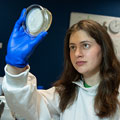Disputed Neandertal region confirmed in France
Posted on 16 September 2016
Châtelperronian body ornaments and bone points from the Grotte du Renne in Arcy-sur-Cure. Credit: Dr. Marian Vanheren.Using ancient protein analysis, the team took part in an international research project to confirm the disputed origins of bone fragments in Châtelperron, France.
Led by the Max Planck Institute (MPI) for Evolutionary Anthropology in Germany, researchers set out to settle the debate as to whether hominin remains in the Grotte du Renne, an archaeological site in Arcy-sur-Cure, France, date to Neandertal ancestry or whether they indicate the first evidence of modern humans in Europe.
Known as the Châtelperronian industry due to numerous artefacts and body ornaments found in this area of central France and northern Spain, the area is critical to the debate regarding the extent of Neandertal cognition, their replacement by modern humans and eventual extinction.
Despite intense research, the exact biological nature of the Châtelperronian people has previously been disputed, with no direct molecular data for a Neandertal association obtained.
However, using peptide mass fingerprinting for rapid, low-cost detection of hominin remains, the team identified 28 additional hominin specimens among previously unidentifiable bone fragments at the Grotte du Renne.
It is thought the bone fragments most likely represent the remains of a single, immature, breastfed individual, with radiocarbon dating being fully consistent with its direct association to Neandertal ancestry.
Professor Matthew Collins, Director of BioArCh at the University of York’s Department of Archaeology and co-author of the paper, said: “For the first time, this research demonstrates the effectiveness of recent developments in ancient protein amino acid analysis and radiocarbon dating to discriminate between Late Pleistocene clades. To identify proteins related to specific developmental stages of bone formation highlights one of the main strengths of this new analysis, especially in a multi-disciplinary context.
“These methods open up new avenues of research throughout Late Pleistocene contexts in which hominin remains are scarce and where the biological nature of remains is unclear due to ancient DNA not being preserved. This represents a significant advance in palaeoproteomic phylogenetics and is of direct relevance to our understanding of hominin evolution.”
Frido Welker, PhD student at the Max Planck Institute for Evolutionary Anthropology and lead author, said: “To differentiate between modern humans, Neandertals and Denisovans on the basis of ancient protein research provides really exciting opportunities for future research into the origins of our and their evolutionary history.”
Professor Hublin, at the Max Planck Institute for Evolutionary Anthropology in Leipzig, adds: “The process of replacement of archaic local populations by modern humans in Eurasia is still poorly understood, as the makers of many palaeolithic tool-kits of this time period remain unknown. This type of research now allows us to extract unrecognisable human fragments out of large archaeological assemblages and to revisit the mode and the tempo of this major event in human evolution with fresh material.”
Further information:
- The article Palaeoproteomic evidence identifies archaic hominins associated with the Châtelperronian at the Grotte du Renne is published in PNAS. To read, visit: http://www.pnas.org.ezproxy.york.ac.uk/content/early/2016/09/13/1605834113 / doi: 10.1073/pnas.1605834113
- The international, multi-disciplinary team consists of researchers from the Max-Planck-Institute for Evolutionary Anthropology (Leipzig, DE), the University of York (York, UK), CRNS (Paris, FR), The Natural History Museum (London, UK), Naturalis Biodiversity Center (Leiden, NL), the University of Oxford (Oxford, UK), and Bournemouth University (Bournemouth, UK).
- The newly- identified hominin material from the site is curated by the Musée National de Préhistoire des Eyzies-de-Tayac, France.
- For more information on the Max Planck Institute for Evolutionary Anthropology, visit: http://www.eva.mpg.de/evolution/
- For further about the University of York’s BioArCh Centre, visit: http://www.york.ac.uk/archaeology/centres-facilites/bioarch/
- Previous research on the study of ancient proteins to determine the phylogenetic position of extinct non-hominin species can be found at: http://www.nature.com/nature/journal/v522/n7554/abs/nature14249.html
Explore more news

Pharmacists could save the NHS billions of pounds with medicines checks, according to analysis by University of York
Monday 6 October 2025

University of York spin-out company receives funding boost
Monday 6 October 2025

Societal inequality linked to structural brain changes in children
Tuesday 30 September 2025

Cancer study to address ‘neglect’ of Gypsy, Traveller and Roma community
Tuesday 30 September 2025

Wolf protection downgrade highlights need for adaptive conservation frameworks, say experts
Thursday 18 September 2025
